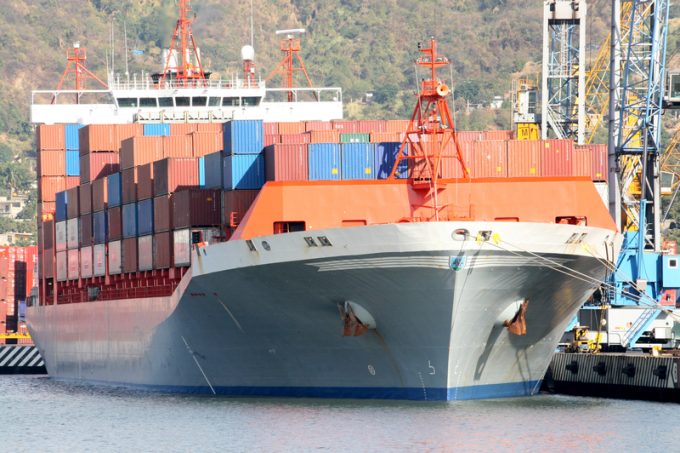Canadian Pacific Kansas City and Americold eye joint expansion in Mexico
Class I railway Canadian Pacific Kansas City and cold chain facility provider Americold are looking ...
FDX: ABOUT USPS PRIVATISATIONFDX: CCO VIEWFDX: LOWER GUIDANCE FDX: DISRUPTING AIR FREIGHTFDX: FOCUS ON KEY VERTICALFDX: LTL OUTLOOKGXO: NEW LOW LINE: NEW LOW FDX: INDUSTRIAL WOESFDX: HEALTH CHECKFDX: TRADING UPDATEWMT: GREEN WOESFDX: FREIGHT BREAK-UPFDX: WAITING FOR THE SPINHON: BREAK-UP ALLUREDSV: BREACHING SUPPORTVW: BOLT-ON DEALAMZN: TOP PICK
FDX: ABOUT USPS PRIVATISATIONFDX: CCO VIEWFDX: LOWER GUIDANCE FDX: DISRUPTING AIR FREIGHTFDX: FOCUS ON KEY VERTICALFDX: LTL OUTLOOKGXO: NEW LOW LINE: NEW LOW FDX: INDUSTRIAL WOESFDX: HEALTH CHECKFDX: TRADING UPDATEWMT: GREEN WOESFDX: FREIGHT BREAK-UPFDX: WAITING FOR THE SPINHON: BREAK-UP ALLUREDSV: BREACHING SUPPORTVW: BOLT-ON DEALAMZN: TOP PICK

Mexico’s top container gateway is going to get a lot bigger: on Saturday Mexican president Claudia Sheinbaum is expected to announce a massive expansion project for the port of Manzanillo that will quadruple its size and add four container terminals.
The Manzanillo branch of the national port administration (ASIPONA) revealed that the president’s announcement will mark the start of construction, which is expected to be completed in 2030.
The Nuevo Manzanillo project will develop 1,880 ha on the Bay of Cuyatlan – an area four times the size of the existing port – to boost its capacity to more than 10m teu a year.
According to retired admiral Mario Alberto Gasque Pena, director general of ASIPONA Manzanillo, this will elevate the port, currently third in Latin America, into the top 15 global gateways.
The first phase envisages construction of two container terminals and a hydrocarbon terminal, a new customs facility and a rail connection to the site. In the second phase, two more container facilities will be added.
ASIPONA identified the handling of containers and hydrocarbons as a particular focus of the project.
Besides the start of construction, the project kicks off with studies to see if the Bay of Cuyatlan meets the requirement for a depth of at least 18 metres throughout and assess if any dredging is needed.
The overall cost of the project is projected to be 63.6bn pesos ($3.13bn), with the larger share of this public-private partnership shouldered by the private sector, which will chip in 48.57bn pesos.
Manzanillo has struggled to cope with the rise in volumes unleashed by near-shoring, which has triggered calls from cargo owners and logistics providers to bolster the port’s capacity. Proposals for a development in the Bay of Cuyatlan have surfaced several times since 2019, but failed to gain traction until now.
ASIPONA has taken some steps to improve efficiency and alleviate the congestion. It has worked on new road access to the northern area of the port in an effort to boost its ability to serve trucks, from 1,000 a day to 6,000, and ordered new x-ray equipment to cut down inspection times, from five minutes to 1-1/2 minutes. The introduction of its Safe Smart Platform as a single window has streamlined the information exchange between users and the port authority, ASIPONA claims.
Still, port users had a rough time at the end of July, when road access was blocked, which left some 5,000 trucks and other vehicles stranded for as long as 24 hours.
There were conflicting explanations for the trucking freeze, but most observers agree that the port’s infrastructure had been overwhelmed by the growth in traffic.
October saw a record 340,837 teu pass through the port. In the first ten months, Manzanillo has handled 3,252,635 teu, an increase of 6.6% on 2023, and this year’s throughput is projected to reach 3.9m teu, up from 3.7m teu in 2023.
The port’s expansion is a welcome step in the right direction, but it remains to be seen if truck and rail links will be able to cope. Customs clearance has been another bottleneck that prompted calls for 24/7 operation.
Listen to this clip from The Loadstar Podcast of host Mike King speaking with Brian Bourke, global chief commercial officer at Seko Logistics, about how shippers are front loading for 2025:
Comment on this article